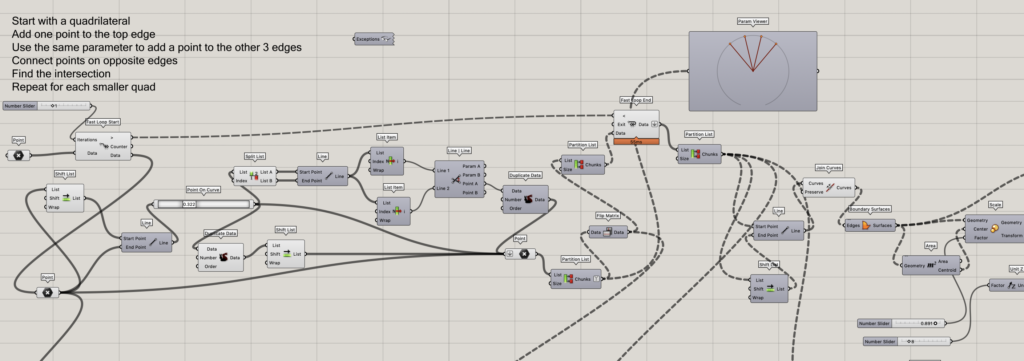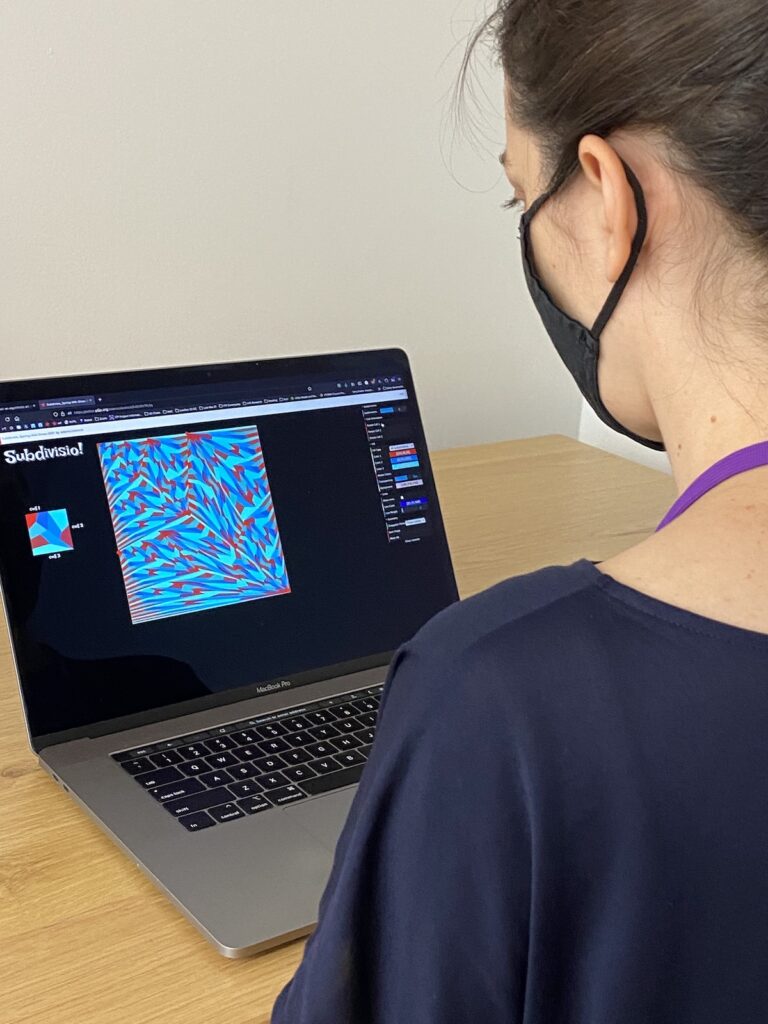Summer – Week 2 – Sculpture progress, explanation page and user-testing
Progress on sculpture
As a small supplement to the web aspect of my experience, I am also spending some time this month using the Grasshopper skills I developed during my 50 Days of Making to create a small digitally fabricated sculpture that uses the same specific algorithm used in Subdivisio as a jumping off point to produce a 3d form.
This week i was focused mainly on refreshing some of my skills in Grasshopper. For my first effort, I decided to simplify the algorithm slightly and just divide a quad into 4 smaller quads using a central point constructed by finding the intersection of two line segments connecting points on opposite sides of the quad. All 4 of the points along the quads edges are defined using a single parameter t that i can vary.
After I got that single subdivision working, I used the Anemone plug-in to create a loop so that the process could be repeated, using the output from one iteration as the input to the next iteration. It was a good exercise to help me start to wrap-my head around the data structures in Grasshopper of items, lists and trees and the methods for working with them. Once I got that working. I extruded each quad to a certain height to create 3d forms. Finally, since i wasn’t sure how to get nested loops to work, I ran the loop 4 times and baked the results after each iteration to create a tiered mish-mosh of subdivision geometry. I’m not sure this is is the final form I want but the techniques i figured out doing this should be helpful whichever direction I head in next.
Here is a screenshot of the Grasshopper code and a close up of the form produced from an interesting angle:


For next week, I will start to think in depth a little bit more about what form I want the sculpture to take and start to transition to writing C# scripts so that looping and recursion as well as data management will be a little more familiar to my way of working.
Developing an explorable explanation
I also spent a fair amount of time this week researching existing explorable explanations to think about what I want the page to look like that describes in more detail how the algorithm works.
In addition to looking at examples, I spent a fair amount of time trying to chunk the concepts into meaningful and palatable ideas as well as deciding on how much detail to include and what language to use. I found that I was probably shooting for somewhere in between formal mathematical description and so simple that it doesn’t generalize or relate to broader mathematical concepts.
I was able to chunk the ideas and develop a written description that I feel pretty comfortable with but I’m still trying to figure out where I want to include static images, moving images or interactive elements.
Here is a screenshot of the intro and the 3 major sections for the algorithm that I decided upon. Each section is elaborated on farther down the page.

User Testing Feedback

This week I was able to do user testing and get feedback from about half a dozen people in my cohort. For the user testing, I opted to have them watch the current introductory video and then try to use the tool to create a design
Several ideas and suggestions seemed to come up a couple of different times. Key among this feedback were the following ideas:
- In general, most people reported the tool to be generally interesting and engaging to play around with. Several people reported spending a surprising amount of time messing around.
- The video in its current form seemed to accomplish the goal of communicating how to use the tool without necessarily giving people quite enough insight or visuals to feel like they understood how it works. Some people reported wishing that they could have just ‘dove right in’ and started creating without having to watch a 5 minute video but others acknowledged that it might be kind of hard to figure out some aspects of the interface without a little bit of guidance.
- Several people reported wishing that the controls have a few more options or that they resemble their associated actions a little bit more. A few people had the experience of enjoying exploring alternative paths for their design by rotating cells but wishing they could more easily go back when they didn’t like where they ended up.
- It was a little mixed in terms of whether people found the cell diagram useful when they were designing. Some found it useful to refer to on their own while others barely noticed it.
- A few people spontaneously brought up the idea of wanting to see a gallery of other people’s designs, perhaps in a mosaic.
- Design processes seemed to alternate between color choices, point positioning, and cell and color rotation. Sometimes people’s compositions would shift as the result of a choice that opened up new possibilities for them.
- For those that were asked to reflect on their design process, some mentioned an intention or feeling that they set out to capture (e.g. an origami bird), some an association or memory that came to mind and that they pursued (staring too closely at a TV screen), some a reaction that they had (Oh wow..I liked when I…), some a general aesthetic such as symmetry, some the optical properties of what was happening (there was some optical illusion stuff happening here), some a preference for certain color combinations or forms, and one person enjoyed discovering that they had ‘discovered’ something when they started to create certain overlaps or ‘negative space’ while working with three draggable points. The variety of the design moments was really interesting to me…but I’m not totally sure what I might do about that.
Takeaways:
- Separate out a mini-onboarding from a more in depth explanation with the former integrated into the experience but skippable for people returning and the latter available as a separate section on the website.
- Consider integrating either an undo option or at least direction options for rotating the cells
- Consider that the mini-onboarding could take place in three chunks distinguished by sections of the control panel and the number of subdivisions
- At 0 subdivisions, highlight the draggable aspect of the red dot
- At 1 subdivision, indicate that a cell has been subdivided using a rule and that depending on the # of draggable points that you select, the position of some of the points depend on each other.
- At 2 subdivisions, highlight that each individual cell has been further subdivided using the rule. But in addition to the rule, a mapping that controls the orientation within each cell is also being applied and can be changed by using the rotate cell buttons.
- Also, at this point color can be incorporated into the design using the two different fill options.
- It seems like a gallery would be a nice feature to try to make sure I integrate into the project sooner rather than later.
- Maybe consider allowing naming, writing a blurb, providing creative prompts or some other additions to the user experience that take advantage of the range of thoughts and processes that came up as people were creating.
Related Posts
1 Comment
Leave a Reply Cancel reply
You must be logged in to post a comment.
Kat Sullivan
Adam Colestock
Helen (Chenuan) Wu
Christina Lan
Dorian Janezic
George Faya
Julia Myers
Kelsie Smith
Michael Morran
Po-Wen Shih
Liu Siyan
Fisher Yu
—
Craig Protzel
Christopher Wray
Haoqi Xia
Hayden Carey
Katherine Nicoleta Helén
Maria Maciak
Parisa Shemshaki
Sakar Pudasaini
Skyler Pierce
Steven Doughty
Yiqi Wang
—
Andrew Lazarow
Benoit Belsot
Enrique García Alcalá
Hongyi Zhang
Jay Mollica
Li Shu
Teddy (Jian) Guo
Monika Lin
Wenye Xie
Yiru Lu

Great takeaways from the feedback session! I agree that this product will work best if this is a ‘pick how you play’ type of interface. Also, in general, I would try and avoid dropdowns in your interface. A small text box with a format checker is typically better UI